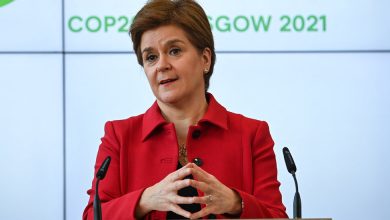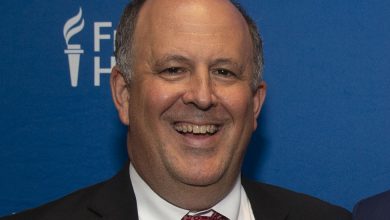Seeding Accounts for Kindergartners and Hoping to Grow College Graduates

Kindergarten often brings a flood of notices about events, school supplies and class photos. But when Vaniqua Hudson-Figueroa’s daughter started at a public school in Queens four years ago, there was one that Ms. Hudson-Figueroa wasn’t expecting: The city had opened a college savings account in her child’s name — and it already had $100 in it.
For Ms. Hudson-Figueroa, the account opens up possibilities she didn’t know she had when she was her daughter’s age.
“When I was a kid, nobody spoke about college,” she said. “There was nothing to talk about.”
The account for her daughter, Mia Issabela, was part of a pilot program that New York City is now opening to every public school kindergartner. Roughly 70,000 students are receiving a college savings account with $100 already invested and the potential to receive up to $200 more.
The establishment of a program by the largest school system in the country is the latest governmental endorsement of accounts meant to use modest investments to help set every child on the path to education beyond high school.
By the time the kindergartners are ready to graduate from high school, the average account is projected to be worth roughly $3,000 — hardly enough to cover books for a four-year degree, even today. But proponents say their value exceeds mere dollars: Researchers have suggested that even small sums in a dedicated college account can significantly increase a child’s likelihood of pursuing higher education.
Ms. Hudson-Figueroa, a 29-year-old personal assistant and now the president of the P.T.A. at her daughter’s school, said the account had sparked conversations about higher education that never happened for her. Her father died when she was 14, and her mother was unable to work after having several strokes.
“My daughter thinks about it all the time,” said Ms. Hudson-Figueroa, who is pursuing a dual bachelor’s and master’s degree in education and psychology. “She knows she has money in there.”
Child savings account programs — also known as child development accounts — have been steadily gaining momentum over the past decade, with initiatives stretching from San Francisco to Maine, two of the earliest pioneers. The money is generally invested in state-run 529 college savings plans, where earnings grow tax-free over time. Withdrawals are free of income and capital gains taxes as long as the money is used for eligible expenses associated with higher education or career training.
State and local governments, as well as school districts and nonprofit groups, set up these programs intending for them to become not only part of the classroom conversation but also part of the community fabric. With the account infrastructure in place, it becomes easier for local groups, corporations and others to direct money to local students, experts said, particularly those with fewer resources.
“I certainly began my research thinking about how really small amounts of money can matter,” said William Elliott III, a professor of social work at the University of Michigan who found that even modest accounts make a child three or four times as likely to pursue higher education. “But I don’t want to lose track of the fact that one of the really important things these kinds of programs do is they provide the infrastructure to transfer wealth to lower-income families.”
Professor Elliott can relate. He grew up in poverty in Beaver Falls, Pa., dropped out of high school and can recall taking walks with his mother through more affluent neighborhoods where they fantasized about living someday. That helped them get through the day, he said, but it didn’t give them any sense of tangible hope.
The accounts can, Professor Elliott said, by offering students and parents a sense of control.
“They feel like they can change their destiny and their future,” he said.
New York’s program automatically enrolls all students regardless of their household financial or immigration status. Shortly after receiving news of their child’s $100 account, families are encouraged to take a series of steps to earn more: Activate the account; open their own 529 account, link it to the scholarship account; and deposit at least $5 into their own. At each of those steps, which will be possible beginning in January, they will earn up to $25.
After that, they will receive a dollar, up to $100, for every dollar saved from first through fifth grade. All money is invested in the NY 529 Direct Plan, in a basket of low-cost Vanguard mutual funds, which gradually become more conservative as high school graduation approaches. Students must use the scholarship money within 20 years of completing kindergarten; otherwise, it will be returned to the program to help future students.
“The big idea is that every kid graduating is going to have a real resource for their higher education for college or career training,” said Debra-Ellen Glickstein, executive director of NYC Kids RISE, the nonprofit organization that manages the program in partnership with the city and its Department of Education.
“That is a message that is being sent from the school, and it is a tool for communities, no matter which community that is, to reinforce the message about what is possible,” she added.
For every public dollar invested, the city expects a return of $15 to $20, generated through philanthropy, family savings, scholarships and investment returns. The city said it would invest $15 million in the program through 2025, while the Gray Foundation, through NYC Kids Rise, provided an additional $15 million.
In 2019, California, Colorado, Illinois and Nebraska passed legislation to create programs, and according to Prosperity Now, there were more than 922,000 children’s savings account programs in 36 states at the end of 2020. That was up 30 percent from the previous year, with most growth driven by state and city-run programs with automatic enrollment, including Maine, Pennsylvania, Nevada and San Francisco.
Pennsylvania’s Keystone Scholars program, created in 2018, is one of largest statewide programs, and automatically provides newborns with $100.
Devon Tiller’s 6-month-old son, Ayvion, was one of them. Just a few months after he was born, Ms. Tiller, a single mother who recently started a second job as a material handler in a warehouse, received a letter explaining that a college account had been opened for her son, with materials on how she could also set up one of her own.
“I had talked to my mom about it, and she and I thought it would have been an amazing thing to get started for my son,” said Ms. Tiller, 29, of Lancaster, who is also trying to open up an account for her 7-year-old daughter, Nevaeh.
Feeling unprepared after high school, Ms. Tiller struggled in community college and ultimately dropped out. “I know life is hard,” she said, “and I don’t want to see them struggle like I have to.”
Child savings accounts were conceived 30 years ago by Michael Sherraden, founder of the Center for Social Development at Washington University in St. Louis, who proposed creating accounts for all children at birth. Since 2007, he has been the lead investigator in an experiment tracking 2,700 newborns in Oklahoma randomly assigned to two groups: Half received $1,000 accounts at birth; the other received nothing. Many programs draw on the center’s research, which has found that the accounts raise both the parents’ and child’s expectations about the child’s future.
Thus far, the biggest beneficiaries of 529 accounts have been more-affluent families who open them on their own. There were 14.3 million 529 accounts totaling $437 billion in assets at the end of June, according to ISS Market Intelligence, a financial research and analytics firm.
But proponents believe that automatically starting accounts will help change that, and can ultimately contribute to narrowing the wealth gap; New York’s so-called baby bonds program is just one part of a broader economic justice initiative. In the pilot school district, certain Astoria students living in public housing already have more than $1,500 in their accounts, thanks in part to scholarships raised through the tenant association.
A similar effort helped Ms. Hudson-Figueroa’s daughter, now in fourth grade, raise her balance to more than $500. The Woodside Houses Resident Association helped raise $35,800 — roughly $218 each — for first through fourth graders at P.S. 151.
As the school’s P.T.A. president, Ms. Hudson-Figueroa is now helping other parents, answering questions and guiding them through the steps they need to take to maximize the savings they’re eligible for.
“The main question I get most of the time is, ‘What do I have to do?’” she said. “And the best part of it is, I can tell them, ‘Your child is already enrolled.’”



